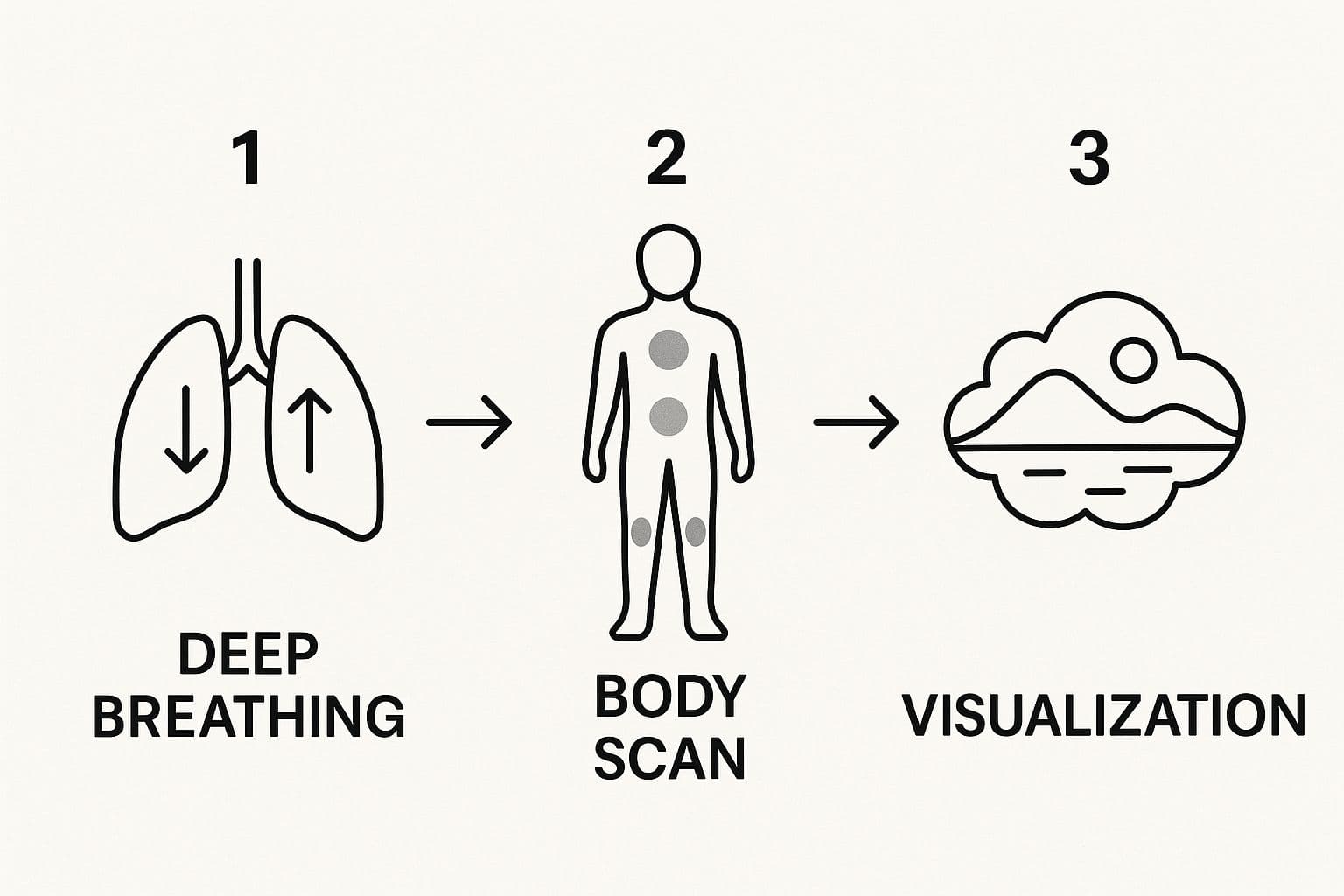Meditation for Falling Asleep
Tired of a racing mind at night? This guide to meditation for falling asleep offers practical techniques to help you find calm and get restorative rest.
Ever find yourself lying awake at night, replaying the day’s events or worrying about tomorrow? If so, you’re in good company. The simple truth is, using meditation for falling asleep isn't about some complex spiritual journey; it’s a practical, down-to-earth tool for calming your nervous system. By gently shifting your focus away from those anxious, looping thoughts, you can clear a path for a peaceful night.
Why a Racing Mind Is Sabotaging Your Sleep

Does your mind feel like a web browser with way too many tabs open the second your head hits the pillow? It's a classic scenario, and it usually means your body is stuck in a stress cycle. After a long day of juggling deadlines, family duties, and a constant barrage of notifications, your brain doesn't just clock out at 10 PM.
Instead, it keeps on processing everything, which can easily flip the switch on your body’s "fight or flight" response. This ancient survival instinct is great for escaping real threats, but it also jacks up your heart rate and keeps you on high alert—the exact opposite of what you need to drift off.
The Cycle of Sleeplessness and Anxiety
This state of high alert kicks off a frustrating loop. You can't sleep because you're anxious, and then you get more anxious because you can't sleep. The longer you lie there, the more your mind fixates on how tired you'll be tomorrow, digging the rut even deeper. Learning how to reduce anxiety naturally and find calm is a huge first step toward keeping that racing mind from ruining your rest.
This is where meditation comes in. It acts as a gentle but firm interruption to that cycle.
By guiding your attention away from future worries and back to the present moment—focusing on your breath, the feeling of the blankets—you activate your parasympathetic nervous system. This is your body's "rest and digest" mode, and it sends a clear signal that it's safe to finally relax.
Mindfulness is the key: The practice isn’t about forcing your mind to be empty. It’s more about changing your relationship with your thoughts. You learn to watch them float by without getting swept away, creating the mental space sleep needs to arrive on its own.
We often think of a racing mind as a problem we need to solve, but meditation shows us a different way. The table below breaks down how this practice directly counters the mental hurdles that keep so many of us awake.
How Meditation Counters Common Sleep Blockers
Common Sleep Blocker | How Meditation Helps |
Worrying about the future (e.g., "What if I fail my presentation?") | Brings you into the present moment. By focusing on your breath, you anchor yourself in the now, not in "what-if" scenarios. |
Replaying past events (e.g., "I can't believe I said that.") | Teaches non-judgmental observation. You learn to see thoughts as just thoughts, not urgent truths, letting them pass. |
Physical tension from stress (e.g., clenched jaw, tight shoulders) | Encourages body awareness. Body scan meditations help you identify and consciously release stored physical stress. |
Frustration about not sleeping (e.g., "Why can't I just fall asleep?!") | Cultivates acceptance. Instead of fighting wakefulness, you learn to rest peacefully in it, reducing the pressure to sleep. |
By addressing these core issues, meditation doesn't just mask the symptoms; it helps rewire your brain’s response to stress at bedtime.
And it’s not just talk; the science backs it up. Research shows that mindfulness meditation offers a statistically significant boost in sleep quality. It’s a proven method for tackling the key drivers of sleep disturbances, helping you finally quiet the mental chatter. For more practical strategies, check out our guide on how to calm anxiety at night.
Creating Your Pre-Sleep Sanctuary

Think of the hour before bed as a gentle runway toward sleep. Your mind needs clear signals that it's time to power down, and your bedroom should be the sanctuary that makes it happen. The small, deliberate act of dimming the lights or silencing your phone starts the process, building a sense of calm.
It’s about more than just a comfy mattress and soft pajamas, though those certainly help. It’s about creating an environment that feels supportive and inviting, not restrictive. Experiment with your pillows or even a slight incline until you find a position that lets your body truly let go.
I’ve found that one of the most powerful signals you can send your brain is silencing that last email alert at least 30 minutes before you plan to close your eyes. It's a simple shift, but it carves out a crucial buffer zone free from screen-induced stress.
Once the visual noise is gone, you can tune your senses to sound. This is where soft audio stories or gentle nature loops come in, guiding your wandering thoughts away from the day's anxieties and toward a state of rest. These small, repeatable actions become the mental signposts that point you directly toward sleep.
Choosing Relaxing Lighting
Your lighting choices can make or break your pre-sleep ritual. Bright, harsh lights are the enemy of melatonin, the hormone that governs your sleep cycle. Warm bulbs that mimic the soft glow of a sunset are your best friend here.
Aim for a gentle ambiance of 200 lux or even lower to encourage your brain's natural melatonin release. If you use smart bulbs, you can even schedule a dimming pattern that automatically softens the light as bedtime approaches. No smart lights? No problem. A simple bedside lamp with a low-wattage bulb works just as well.
Get a bedside lamp with a dimmer switch. This gives you total control, allowing you to dial down the brightness in small increments.
Swap out any harsh overhead lights for warm white bulbs. Look for a color temperature of around 2700K to create that perfect, cozy glow.
Final Touches For Your Ritual
With the atmosphere set, it's time to settle into your favorite sleeping position. For some, that’s curled up on their side; for others, it might be propped up slightly with a backrest. Find what feels right for you tonight.
Now for the final touch: select a guided audio track. A casual fantasy bedtime story can be the perfect final step, gently easing your mind away from the real world and into a story.
For more ideas on how to craft the perfect wind-down, check out our guide on building a https://www.otherworldtales.com/blog/relaxing-evening-routine. The tips there pair perfectly with meditation for falling asleep.
And if you want to take a deeper dive into creating the ideal sleep environment, have a look at a comprehensive guide to sleep hygiene.
Tip: The key is repetition. Practice this same pattern every night, and soon enough, your mind will automatically associate this ritual with deep, restorative rest.
Pay attention to the narrator's voice. Choose voices that you find genuinely warm and familiar.
Don't be afraid to mix in some gentle rain, wind, or white noise. These sounds are fantastic for masking distracting household noises.
This simple setup primes your mind and body for your meditation. When you make this pre-sleep ritual a habit, you’ll find your mind recognizes the cues and settles down much more quickly, boosting the power of your deep sleep meditation.
Simple Guided Meditation Techniques for Bedtime
Starting a meditation practice to help you fall asleep is far easier than you might think. You don't need any special gear or years of experience—just a bit of patience and a willingness to be gentle with yourself. The goal here isn't to force your mind into silence. It’s about giving it a peaceful place to rest.
Below, we’ll walk through three simple but powerful techniques. Each one offers a different path to quiet the mental chatter that loves to show up right when the lights go out. Think of these less like rigid rules and more like friendly invitations to relax.
This little chart shows how these practices can build on each other, creating a state of deep relaxation perfect for drifting off.

As you can see, the journey to calm often starts with the breath, moves into physical relaxation with a body scan, and can finish by engaging the mind with gentle visualization.
The Gentle Body Scan
The Body Scan is a classic for a reason. It's a foundational practice that works wonders for releasing physical tension you didn't even realize you were carrying from the day. The whole idea is to bring slow, deliberate attention to different parts of your body, one by one.
Get comfortable and bring your focus to your toes. Just notice what’s there—warmth, tingling, tightness—without judging it. As you breathe out, imagine all the tension just melting away from that area. From there, you slowly work your way up your body: feet, ankles, calves, and so on, all the way to the crown of your head. This anchors your mind in the present moment and systematically coaxes your entire body to let go.
A Quick Tip: Your mind will wander. That’s what minds do. When it happens, just gently notice the thought and guide your focus back to whatever part of the body you were on. The real magic isn't in perfect focus, but in the gentle act of returning, again and again.
Peaceful Place Visualization
Once your body feels a bit more grounded, you can try a visualization meditation. This technique simply uses your imagination to create a tranquil mental escape, giving your mind a soothing focal point that isn't your to-do list.
Picture yourself in a place where you feel completely safe and at peace. Maybe it’s a quiet beach at sunset, a cozy cabin with a crackling fire, or a forest clearing bathed in soft moonlight. Really try to engage all your senses:
What do you see? Notice the colors, the light, the little details.
What do you hear? Is it the sound of gentle waves, rustling leaves, or just a deep, peaceful silence?
What do you feel? Can you imagine the warmth of the sun on your skin or the softness of a blanket?
By immersing yourself in this serene environment, you can trigger a genuine relaxation response in your body.
Loving-Kindness Meditation
Finally, a Loving-Kindness meditation is an incredibly powerful tool for quieting that inner critic that often gets louder at bedtime. The practice is simple: you silently repeat phrases of goodwill, first toward yourself and then toward others.
Start with yourself. In your mind, gently repeat phrases like, "May I be happy. May I be healthy. May I be peaceful." After a few rounds, you can extend these well wishes to people you love, or even neutral people in your life. This simple act of cultivating compassion helps dissolve feelings of anxiety and self-judgment, creating a warm, accepting inner atmosphere that’s perfect for drifting off to sleep.
Using Your Breath to Calm Your Nervous System
Your breath is one of the most powerful and direct tools you have for shifting how you feel, both physically and mentally. Think about it: when your mind is racing, your breathing almost always becomes shallow and quick. This isn't just a coincidence; it's a signal to your body that you're in a state of stress.
The good news is that you can consciously reverse this process. By intentionally slowing down your breath, you can activate your parasympathetic nervous system—what's often called the body’s natural “rest and digest” mode.
This isn’t just some vague feeling of calm. This physiological shift tangibly lowers your heart rate and blood pressure, sending a clear, undeniable message back to your brain: you are safe. Learning to guide your breath is a fundamental first step in any sleep meditation, turning an automatic process into a deliberate act of relaxation.
A quick word of advice: the goal is never to force your breath. That can ironically create even more tension. Instead, think of it as gently guiding your focus, allowing the rhythm to naturally become smoother and deeper over time.
The 4-7-8 Breathing Technique
One of the most effective methods I've come across for quieting anxiety is the 4-7-8 breathing technique. Its structure is deceptively simple but incredibly powerful for interrupting a cycle of stressful, looping thoughts.
Here’s how it works:
Inhale Quietly: First, close your mouth and inhale quietly through your nose for a mental count of four.
Hold Your Breath: Now, hold your breath for a count of seven. This is the most crucial part of the practice. It gives your body a moment to fully absorb the oxygen and calm itself.
Exhale Completely: Finally, exhale completely through your mouth, making a gentle whoosh sound, for a count of eight.
Try repeating this cycle just three or four times when you're first starting out. That long exhale is key, as it stimulates the vagus nerve, which plays a central role in slowing your heart rate and easing you into a state of calm.
Classic Box Breathing
Another fantastic technique is Box Breathing, sometimes called square breathing. People love it because of its simplicity and its steady, rhythmic nature, which gives your mind a predictable pattern to latch onto. All you have to do is imagine drawing a square with your breath.
Inhale slowly through your nose for a count of four.
Hold your breath at the top for a count of four.
Exhale gently through your mouth for a count of four.
Hold your breath at the bottom for a final count of four.
Pro Tip: Don't get hung up on the exact counts. If a four-second count feels too long or stressful, just start with three. The consistency of the rhythm is far more important than the specific duration. The goal here is to find a comfortable, sustainable pace that soothes your nervous system, not to perform perfectly.
By focusing on these simple, ancient patterns, you give your racing mind a gentle anchor. Instead of chasing worries around in circles, you're focused on the simple, vital rhythm of your own breath. You're paving the way for sleep to arrive naturally, on its own terms.
Finding the Right Sleep Stories and Sounds

Let's be honest, sometimes trying to force a completely silent mind feels impossible. Your thoughts just keep bouncing around, replaying the day's events or stressing about tomorrow. This is exactly where audio can be a total game-changer for your sleep meditation practice.
A guided sleep story or some ambient nature sounds can gently capture your attention, giving your racing mind a peaceful focus point instead of getting tangled up in worries.
We've seen a massive turn toward these kinds of tools recently. During the pandemic, the need for accessible stress management became crystal clear, with global meditation activity surging by an astonishing 2,900% between March and September 2020 alone. You can dig into more of these wellness trends over at Statista. It shows just how many of us are looking for a better way to unwind.
Selecting Your Ideal Soundscape
Choosing the right audio is deeply personal. A narrator's voice that one person finds incredibly soothing, another might find grating or distracting. It's all about what works for you.
For Sleep Stories: Don't just pick one at random. Listen to a few samples and pay close attention to the narrator’s pacing and tone. Do you prefer a calm, steady voice that almost fades into the background, or one with a bit more gentle inflection to keep you lightly engaged? The goal is to find a voice that feels like a comforting presence in the room.
For Ambient Sounds: Think about what sounds you find genuinely relaxing in real life. Is it the steady drone of white noise that blocks everything else out? The gentle patter of rain against a window? Or maybe the soft rustling of wind through trees?
The key is to find audio that occupies your mind just enough to keep anxious thoughts at bay, but not so much that it keeps you awake and engaged. It's a delicate balance.
Don't be afraid to experiment with layering sounds, either. I've found that playing a fantasy bedtime story with a soft rain soundscape in the background can be incredibly effective. Our guide on sound therapy for relaxation has even more tips on creating that perfect audio environment to help you drift off.
Common Questions About Sleep Meditation
Jumping into something new always brings up a few questions. When you first start using meditation to help you fall asleep, it's totally natural to wonder if you’re "doing it right."
Let's clear up some of the most common worries people have. My goal here is to give you practical, reassuring answers to help you stay on track and get the rest you need.
What if My Mind Is Still Racing?
This is the big one. So many people worry that because their mind is still buzzing with thoughts, they must be failing at meditation.
Let me be clear: This is completely normal and, in fact, expected. You are absolutely not doing it wrong. The point of sleep meditation isn't to force your mind to become a blank slate—that’s pretty much impossible.
It’s about practicing the art of noticing when your thoughts have wandered off, and then gently, without judgment, guiding your focus back to your breath or the story you're listening to.
Every single time you bring your attention back, you're successfully building the mental “muscle” of letting go. Think of it as a rep at the gym. Each time you notice and return, you get a little stronger.
What If I Fall Asleep During Meditation?
That’s fantastic—it means it’s working!
The goal isn't to perfectly "finish" the practice; it's to relax enough to drift off. Don't ever worry about falling asleep mid-session. If you happen to wake up later in the night, you can simply restart the audio or do a gentle breathing exercise to ease back into rest.
For sleep meditation, lying down is definitely the way to go. Unlike meditations designed for daytime focus where sitting up is encouraged, the "risk" of dozing off here is actually the desired outcome. Get into whatever position is most comfortable for you in bed so you can transition smoothly into sleep.
How Long Until I See Results?
This really varies from person to person. Some people feel a noticeable difference on the very first night. For others, it might take a week or so of consistency to really feel the benefits pile up.
The key is to be patient with yourself. Treat it like learning any new skill—the more you practice, the more naturally and quickly your mind will learn to settle down when it's time for bed.
Ready to give your racing mind a peaceful story to focus on? Explore the library of fantasy and mythology bedtime stories at Otherworld Tales. Our built-in audio player lets you mix in calming sounds like rain or wind, creating the perfect soundscape to help you drift off. Discover your new favorite sleep story today.